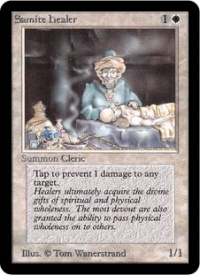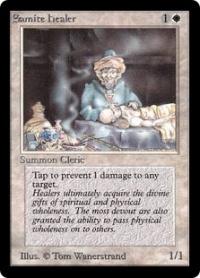Core Sets
Magic sets can be separated into two types, expansion sets and Core Sets. Core Sets are released annually. Before the 6th Edition these sets were release every two years with white borders and without an expansion symbol. The absence of an expansion symbol occasionally makes it hard for beginners to identify from which Core Set a card comes from. This guide is meant to help you identify the correct edition of a card.
Limited Edition - Alpha / Beta


This was the original Magic: The Gathering. It was released on 5 August 1993 at GenCon. The original Limited Edition was split in two different printings, though. The smaller Alpha run had a bunch of mistakes which were corrected in the larger Beta run. Both parts of the Limited 1st Edition have black borders which makes them very easily identifiable as they are the only black-bordered regular Magic cards without an expansion symbol.
Alpha and Beta cards are most easily told apart by the form of the cards. When you encounter an Alpha card for the first time you will be surprised to find out that Alpha cards have noticeably rounder corners than other Magic cards. This is no joke, it is indeed the cardboard that is cut differently. For that reason Alpha cards were for a long time banished from tournament play in decks that also included non-Alpha cards. In contrast Beta cards look just like normal Magic cards. They are black-borded and have no expansion symbol.
Alpha and Beta versions of a card are usually the most valuable versions of any given card and often command premiums that may seem extreme to a non-collector. The total print run of the Limited Edition is known to be about 10,000,000 cards with about 2.6 million Alpha cards and 7.3 million Beta cards. This means that there should at some point have been about 1,500 copies of each Alpha rare card and about 4,000 copies of each Beta rare card.
In addition to some mistakes on Alpha cards, some Alpha cards simply don't exist. There were no Volcanic Island and no Circle of Protection: Black in Alpha. Also each basic land has only two different pieces of art whereas a third was added in Beta.
Unlimited Edition

The Unlimited Editon or 2nd Editon was released on 1 December 1993. It is the last set to include the Power Nine. Unlimited cards are identical to Beta cards with the exception of the borders. Beta cards have black borders, Unlimited cards have white borders. While this makes Unlimited cards easy to separate from Beta cards, Revised Edition cards occasionally look very similar to Unlimited cards.
Unlimited cards have a white border, no expansion symbol, and no year in conjunction with the copyright. As this is all true for the Revised Edition cards as well these are quite hard to tell apart. The true difference between Unlimited and Revised lies at the border of the card, but is barely visible if you are not looking for it. If you start let your look ramble over the card beginning at the edge, sliding inward, you will start off on the white frame of the card. Afterwards comes a thin black line that separates the card frame from the inner border. Immediately inside that black line you will encounter either directly the inner border of the card or a slight bevel between the border and the black line. If the edge is beveled you have an Unlimited card, otherwise it is a Revised Edition card.
There are some other characteristics which are different in Unlimited and Revised Edition, too. For Revised Edition the first tap symbol, a tilted 'T' premiered. Unlimited Edition cards never have a tap symbol. If a card needs to tap the word 'tap' is always written out. Artifacts are most easy to tell apart because in Revised Edition an Artifact has always the card type 'Artifact' whereas in Unlimited it is always either a 'Mono', 'Poly', or 'Continuous' artifact. Finally the colors of Unlimited Edition cards are usually way more saturated than those of Revised Edition cards. Revised is actually most (un)famous for its very washed-out look. Unlimited doesn't have that. On the other hand Unlimited cards have a wide range of saturation. Some cards look almost like Revised Edition cards while others are so powerfully saturated that you wouldn't confuse them in a dark room. All things considered: If you are in doubt, learn to look for the bevel! It's not that difficult after all.
The print run of Unlimited was announced to be 40,000,000. Thus there are about 25,000 copies of each Unlimited rare card.
Revised Edition

The Revised Edition or 3rd Edition went on sale in April 1994. It is the last set to include the original dual lands. Revised Edition cards are white bordered, have no expansion symbol and no date going with their copyright. As Revised Edition cards are the last Core Set cards without a year date in the copyright they are quite easily distinguishable from later Core Sets. They are easily confused with Unlimited cards, though. Look in the section on Unlimited on how to tell these apart.
The print run of Revised is roughly estimated to be around 500 million cards. While it is not clear if that accounts for foreign releases this would mean that in the order of 300,000 copies of each Revised rare exist.
Foreign black bordered Core Sets (Revised and 4th Edition)
Since 1994 Magic cards are produced in other language than English. The original release of a Core Set in a new language was usually black bordered, and is thus easily identifiable. Hence French, German, and Italian black bordered cards without an expansion symbol are from the language's Revised Edition. Black Bordered cards in Chinese (traditional), Japanese, Portuguese, and Spanish are from 4th Edition as production of these languages started only after Revised went out of print. There are also comparable black bordered Russian cards, but these have the 9th Edition expansion symbol anyway. Only Chinese (simplified) doesn't have an original black bordered release.
Cards from these sets are usually highly sought after and thus rather expensive. The dual lands from the black bordered Revised Editions are particularly valuable as they are the only alternative to super-expensive Alpha/Beta duals for a player that wants to play black bordered cards.
Foreign white bordered Core Sets (Revised to 5th Edition)
The first black bordered printing in a foreign language was in some cases immediately followed by a white bordered printing of the same set. There are two versions, one white bordered and one black bordered, of the French, German, and Italian Revised Edition. Unfortunately these cards are basically indistinguishable from their 4th Edition counterparts. Japanese, Portuguese, and Spanish have white and black bordered versions of 4th Edition. For Chinese (traditional) and Korean there are only the black bordered versions of 4th Edition, and Chinese (simplified) only has a white bordered version of 5th Edtion, but not black bordered version altogether.
4th Edition

4th Edition went on sale in April 1995. Fourth Edition cards are white-bordered and have no expansion symbol. They have a copyright of 1995 which makes them easily identifiable. The colors of Fourth Edition are way more saturated than those of Revised and uniform in contrast to those of Unlimited. The beveled edge was restored. The tilted 'T' that was used as a tap symbol in Revised was replaced by a predecessor to the modern tap symbol, a turned arrow. Starting with 4th Edition white cards use the modern white mana symbol. The original symbol used until Revised looked slightly different.
5th Edition

5th Edition went on sale in March 1997. Fifth Edition cards are white-bordered and have no expansion symbol. They have a copyright of 1997 which makes them easily identifiable. The colors of Fourth Edition are not quite as saturated as those of 4th Edition. Fifth Edition is the first Core Set that features different artwork from the original cards, but not on all cards.
6th Edition and onwards
From 6th Edition onwards all Core Sets have expansion symbol and are thus easily identifiable. These symbols are:
- 6th Edition: a roman 6: VI
- 7th Edition: a regular 7
- 8th Edition: a regular 8 over three fanned cards
- 9th Edition: a regular 9 over three fanned cards
- 10th Edition: a roman 10: X
- Later sets: a M followed by the year date (M2010, M2011 etc.)
Chronicles
Chronicles is not a regular Core Set, but was termed an expansion directly to the Core Set. Originally it was planned to have such sets regularly but Chronicles was the only extension to a Core Set, in this case 4th Edition. Chronicles cards are white bordered, but have the expansion symbol of the set they originally appeared in. The copyright is 1995.
Renaissance
Renaissance is a set that was released in 1995. Its cards are available only in French, German, and Italian. Renaissance is considered an expansion for 4th Edition, and was created with the idea of making certain cards available in French, German, and Italian with black borders. Cards from Renaissance are blackbordered and have the expansion symbol of the card's original set.
Special sets
Collectors Edition / International Edition
Collectors Edition cards were never meant to be used in tournament play, but as the name suggest are for collectors' purposes only. Both the Collectors Edition and the International Editon were sold as complete sets in boxes. The cards have square corners and either 'Collectors Edition' or 'International Edition' written in gold on their back. Also the frame on the back is golden instead of black. Their frequent use in Highlander and proxy vintage tournaments has created some demand and consequently a surprisingly high price for these cards.
Summer Magic
Summer Magic, originally codenamed Edgar, is the second print run of Revised Edition that never made it to the public due to several mistakes in the product and Wizards thus had the cards destroyed, only not all of them were actually destroyed. The surviving cards are freakishly rare. It is unknown how many cards exist. The best serious estimate is "a few booster boxes survied" which makes those cards freakishly rare, so rare in fact that no real market prices exist for these cards. The famous blue Hurricane is from this "set". Summer Magic cards have a copyright of 1994 and are thus easily told apart from the otherwise identical Revised Edition cards.
Alternate 4th Edition
Wizards made these when their were in search for a different manufacturer. Wizards was not convinced by the quality of the product they received and abandoned the search. It is unknown why Wizards looked for another manufacturer or how the remaining cards were leaked to the public, but fact is there are a couple of these around. Alternate 4th Edition cards are hard to identify, especially if you are not looking for them. Their stock is a bit thicker than that of normal Magic cards and they have a glossy overcoat on the back. Also they don't glow under blacklight and their printing style is different from normal Magic cards. This can be best observed with a magnifying lense. Finally the letters of the word 'Magic' on the backside are darker on alternate 4th Edition cards. The 'A' is most notably affected by this.
If you still have any questions or wish to view your open or closed tickets, please visit the Help Desk.